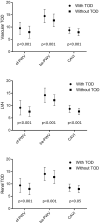Association between measurements of arterial stiffness and target organ damage in a general Spanish population
- PMID: 33533280
- PMCID: PMC7877984
- DOI: 10.1080/07853890.2021.1881812
Association between measurements of arterial stiffness and target organ damage in a general Spanish population
Abstract
Introduction: Little is known about the relationship between arterial stiffness and cardiovascular target organ damage (TOD) in the general population. The aim was to analyse the relationship between different measurements of arterial stiffness and TOD, in a general Spanish population without a history of cardiovascular event.
Materials and methods: Transversal descriptive study. Through stratified random sampling, a total of 501 individuals were included. Carotid-femoral pulse wave velocity (cf-PWV) was measured using a SphygmoCor System®, the cardio-ankle vascular index (CAVI) was determined with aVasera VS-1500® and brachial-ankle pulse wave velocity (ba-PWV)was calculated through a validated equation.
Results: The average age was 55.84 ± 14.26.The percentage of vascular TOD, left ventricular hypertrophy (LVH) and renal TOD was higher in men (p < .001). A positive correlation was obtained between carotid intima-media thickness (c-IMT) and the measurements of vascular function. In the model 1 of the logistic regression analysis, cf-PWV was associated with vascular TOD (OR = 1.15, p = .040), ba-PWV was associated with vascular TOD (OR = 1.20, p = .010) and LVH (OR = 1.12, p = .047).
Conclusions: The different measurements of arterial stiffness are highly associated with each other. Moreover, cf-PWV and ba-PWV were associated with vascular TOD, and ba-PWV with LVH, although they disappear when adjusting for cardiovascular risk factors. Key Messages There is a strong correlation between the different measurements of vascular structure and function. Carotid-femoral and brachial-ankle pulse wave velocity were positively associated with vascular target organ damage, the latter was also positively associated with left ventricular hypertrophy. This associations disappear when adjusting for cardiovascular risk factors.
Keywords: Vascular stiffness; target organ damage; vascular function; vascular structure.
Conflict of interest statement
The authors declare that there is no conflict of interest.
Figures




References
-
- Willum-Hansen T, Staessen JA, Torp-Pedersen C, et al. Prognostic value of aortic pulse wave velocity as index of arterial stiffness in the general population. Circulation. 2006;113(5):664–670. - PubMed
-
- Vlachopoulos C, Aznaouridis K, Terentes-Printzios D, et al. Prediction of cardiovascular events and all-cause mortality with brachial-ankle elasticity index: a systematic review and meta-analysis. Hypertension (Dallas, Tex.: 1979). 2012;60(2):556–562. - PubMed
-
- Vlachopoulos C, Aznaouridis K, Stefanadis C.. Prediction of cardiovascular events and all-cause mortality with arterial stiffness: a systematic review and meta-analysis. J Am Coll Cardiol. 2010;55(13):1318–1327. - PubMed
-
- Tanaka H, Munakata M, Kawano Y, et al. Comparison between carotid-femoral and brachial-ankle pulse wave velocity as measures of arterial stiffness. J Hypertens. 2009;27(10):2022–2027. - PubMed
-
- Zhang Y, Agnoletti D, Protogerou AD, et al. Characteristics of pulse wave velocity in elastic and muscular arteries: a mismatch beyond age. J Hypertens. 2013;31(3):554–559. discussion 9 - PubMed
Publication types
MeSH terms
LinkOut - more resources
Full Text Sources
Other Literature Sources
